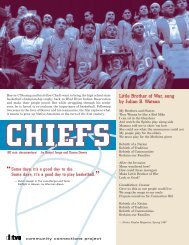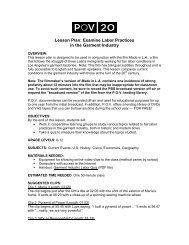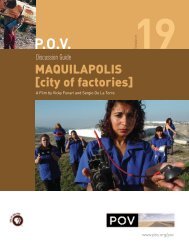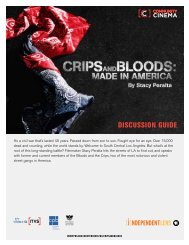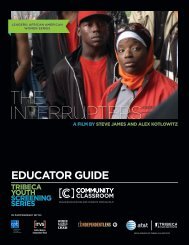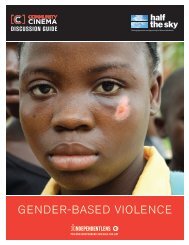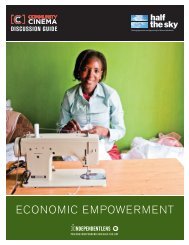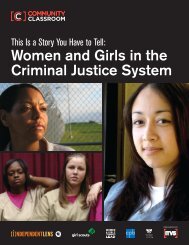Wonder Women! The Untold Story of American Superheroines - ITVS
Wonder Women! The Untold Story of American Superheroines - ITVS
Wonder Women! The Untold Story of American Superheroines - ITVS
- No tags were found...
You also want an ePaper? Increase the reach of your titles
YUMPU automatically turns print PDFs into web optimized ePapers that Google loves.
DISCUSSION GUIDE<strong>Wonder</strong> <strong>Women</strong>!<strong>The</strong> <strong>Untold</strong> <strong>Story</strong> <strong>of</strong> <strong>American</strong> <strong>Superheroines</strong>PBS.ORG/INDEPENDENTLENS/WONDER-WOMEN
Table <strong>of</strong> Contents1 Using this Guide2 From the Filmmaker3 <strong>The</strong> Film4 Background Information5 Feminism — A Brief Review6 How Are <strong>Women</strong> Doing?6 <strong>Women</strong>, the Mass Media, and Popular Culture7 Portrayal on the Small Screen7 More <strong>Women</strong> Needed8 Thinking More Deeply9 Suggestions for Action10-11 Resources12 Creditsnational center forMEDIA ENGAGEMENT
Using this GuideCommunity Cinema is a rare public forum: a space for people to gather who areconnected by a love <strong>of</strong> stories, and a belief in their power to change the world.This discussion guide is designed as a tool to facilitate dialogue, and deepen understanding<strong>of</strong> the complex issues in the film <strong>Wonder</strong> <strong>Women</strong>! <strong>The</strong> <strong>Untold</strong> <strong>Story</strong> <strong>of</strong> <strong>American</strong><strong>Superheroines</strong> . It is also an invitation to not only sit back and enjoy the show — but tostep up and take action. This guide is not meant to be a comprehensive primer on agiven topic. Rather, it provides important context, and raises thought provoking questionsto encourage viewers to think more deeply. We provide suggestions for areas to explorein panel discussions, in the classroom, in communities, and online. We also providevaluable resources, and connections to organizations on the ground that are fighting tomake a difference.For information about the program, visit www.communitycinema.orgDISCUSSION GUIDE // WONDER WOMEN!1
From the FilmmakerLike most women and men <strong>of</strong> my generation, I grew up with Lynda Carter’s <strong>Wonder</strong> Woman TV show. Itwas the late ‘70s, the show was already in the constant rotation <strong>of</strong> syndication, and there simply wasn’tanything else out there that captured my imagination as a little girl. I had friends who were <strong>Wonder</strong> Womanfor Halloween year after year because there were so few options for girls as fantasy heroes.When I started telling people about this film, men and women hadwildly different reactions. Most <strong>of</strong> the guys admitted that <strong>Wonder</strong>Woman was their first TV crush. <strong>Women</strong> reminisced about howthey pretended to be her: twirling a rope to capture foes or spinningto transform themselves into superheroes.Fast-forward some thirty years and I was reading a New YorkTimes article that introduced Gail Simone as (the comic book)<strong>Wonder</strong> Woman’s first female “ongoing writer” EVER. Here wasthis incredible feminist symbol who had always been stuck, like alot <strong>of</strong> strong female characters, between being created by menand being primarily consumed by boys.<strong>The</strong> story stayed with me, and I began looking into <strong>Wonder</strong>Woman’s origins. Her creator, William Moulton Marston, was afascinating character who set out to create an empowering rolemodel amid a lot <strong>of</strong> superviolent male heroes. Of course, he alsohad some interesting ideas about what a strong female heroshould look like. But his creation has endured while so manyothers have been forgotten.I loved the idea <strong>of</strong> looking at something as populist as comics toreveal our cultural obsessions — in particular, how women’s roleshave changed over time. <strong>The</strong> narratives <strong>of</strong> our most iconic superheroes,told and retold over decades, boldly outline our shiftingvalues. That’s one story <strong>Wonder</strong> <strong>Women</strong>! tells, but to me, it’s notthe most interesting one. I hope the film also conveys the unpredictableways those icons can shape and even transform us inreturn. For some it’s Tomb Raider’s Lara Cr<strong>of</strong>t, for others it’s Buffythe Vampire Slayer, but we all need those iconic heroines who tellus we have the power to slay our dragons and don’t have to waitaround to be rescued.Kristy Guevara-FlanaganFilmmakerDISCUSSION GUIDE // WONDER WOMEN!2
<strong>The</strong> FilmComic books have been a staple <strong>of</strong> <strong>American</strong> popular culturesince the 1920s, but their popularity soared when the adventures<strong>of</strong> superheroes began filling their pages in the late 1930s.For a population coming out <strong>of</strong> the Great Depression, comicbooksuperheroes provided a much-needed boost to the spirits.Overwhelmingly, these action heroes were men — until 1941,when a female superhero arrived on the scene and captured theimagination like no others before her. She was <strong>Wonder</strong> Woman,and <strong>Wonder</strong> <strong>Women</strong>! tells the story <strong>of</strong> her creation and herenduring popularity as a role model and feminist icon.<strong>Wonder</strong> Woman was created by William Moulton Marston, aHarvard-educated lawyer and psychologist. Marston was a strongsupporter <strong>of</strong> the early 20th-century movements for women’srights. He felt that women were the key to world peace and thatfostering feminine values <strong>of</strong> harmony and strength through lovewould set humanity on the right path. In addition to showing thatthere was an alternative to the physical violence <strong>of</strong> male superheroes,Marston’s <strong>Wonder</strong> Woman served as propaganda for asystem <strong>of</strong> female rule.<strong>Wonder</strong> Woman was a patriotic symbol during World War II aswomen entered the workforce to take the place <strong>of</strong> men, but oncethe men returned after the war, she morphed into a more docile,traditional female. Over the next several decades, the comic-bookcharacter <strong>of</strong> <strong>Wonder</strong> Woman mirrored the changes in women’sroles and status in <strong>American</strong> society. <strong>The</strong> feminist movement <strong>of</strong>the 1960s, looking for a figure that embodied strong womanhood,returned to the original depiction <strong>of</strong> <strong>Wonder</strong> Woman, who burstonto the cover <strong>of</strong> the first issue <strong>of</strong> Ms. magazine. In the wake<strong>of</strong> the popularity <strong>of</strong> the 1970s <strong>Wonder</strong> Woman TV show, othersuperheroines appeared, both on TV and in movies. <strong>The</strong> portrayal<strong>of</strong> women in the mass media underwent numerous changes, frommuscular, gun-toting, male-like characters to s<strong>of</strong>ter, self-sacrificingindividuals, reflecting not just societal attitudes toward womenbut also the demographics <strong>of</strong> mass-media production, where 97percent <strong>of</strong> the decision-making positions are held by men.An array <strong>of</strong> experts appears in the film, extolling the virtues <strong>of</strong><strong>Wonder</strong> Woman and emphasizing the importance <strong>of</strong> female rolemodels in the mass media. From feminist leader Gloria Steinem t<strong>of</strong>ourth grader Katie Pineda, the message is that we need superheroinesin our lives. <strong>The</strong> enduring appeal <strong>of</strong> <strong>Wonder</strong> Womanrests on what she symbolizes — strength, love, truth, a sense <strong>of</strong>fairness and justice, and an unending quest for harmony amonghuman beings.Selected Individuals Featured in <strong>Wonder</strong> <strong>Women</strong>! <strong>The</strong> <strong>Untold</strong><strong>Story</strong> <strong>of</strong> <strong>American</strong> <strong>Superheroines</strong>Danny Fingeroth — Author, Superman on the Couch: WhatSuperheroes Really Tell Us about Ourselves and Our SocietyMike Madrid — Author, <strong>The</strong> Supergirls : Fashion, Feminism, Fantasy,and the History <strong>of</strong> Comic Book HeroinesGloria Steinem — Feminist; JournalistJennifer Stuller — Author, Ink-Stained Amazons and CinematicWarriors: Superwomen in Modern MythologyTrina Robbins — Author, <strong>The</strong> Great <strong>Women</strong> SuperheroesL. S. Kim — Associate pr<strong>of</strong>essor <strong>of</strong> Film and Digital Media, UCSanta CruzDr. Kathleen Noble — Psychologist; AuthorLynda Carter — Actress, <strong>Wonder</strong> WomanLindsay Wagner — Actress, <strong>The</strong> Bionic WomanJudith “Jack” Halberstam — Pr<strong>of</strong>essor; Author, Female MasculinityDr. Katy Gilpatric — SociologistKathleen Hanna — Lead singer, Bikini Kill; Co-founder,Riot Grrrl zineJane Espenson — TV writer, Buffy the Vampire SlayerJehmu Greene — Former president, <strong>Women</strong>’s Media Center(Find more information on featured individuals atwonderwomendoc.com)DISCUSSION GUIDE // WONDER WOMEN!3
Background Information<strong>The</strong> Need for Superheroes…Superheroes figure prominently in our national culture. <strong>The</strong>y “star”in a variety <strong>of</strong> media — print, TV, film, video games — and the size <strong>of</strong>audiences for superhero movies is just one measure <strong>of</strong> their widespreadpopularity. <strong>The</strong> attractiveness <strong>of</strong> these larger-than-life figuresis not a modern phenomenon. Human history is filled with heroictales, from the mythology <strong>of</strong> the Greeks and Romans, to the Norselegends, to the tall tales <strong>of</strong> the <strong>American</strong> West.Why are we so drawn to these characters? What is their appeal?On one level, they provide role models who exemplify “good” behavior,showing us the right thing to do. When they use their superhumanpowers to conquer wrongdoers, we can glimpse the possibility<strong>of</strong> overcoming “evildoers” in our own lives. On another level, stories<strong>of</strong> heroes and superheroes help us understand what <strong>of</strong>ten seemsto be a chaotic world. Ancient peoples created myths to explainthe causes <strong>of</strong> both natural and man-made events, to impose a kind<strong>of</strong> clarity on an otherwise mysterious world. By drawing clear linesbetween good and evil, superheroes strive to maintain an ideal society,where good is rewarded and evil is rooted out. Through theirselfless actions they champion the moral and the ethical, showingus that we too can follow their path to creating a better world, andin this way, they give us hope.… and <strong>Superheroines</strong>Comic-book superheroes began appearing in the 1930s with thecreation <strong>of</strong> Superman in 1938, and until <strong>Wonder</strong> Woman camealong in the early 1940s, almost all comic-book action heroeswere men. <strong>Wonder</strong> Woman’s creator, William Moulton Marston(see sidebar), recognized that the superhero role should not belimited to men using aggressive force and physical prowess astheir main weapons. Marston saw the need for a female herowho combined strength and love to fight evil and who would alsoserve as a positive role model for girls. “Not even girls want tobe girls so long as our feminine archetype lacks force, strength,and power,” he said. “<strong>The</strong> obvious remedy is to create a femininecharacter with all the strength <strong>of</strong> Superman plus all the allure<strong>of</strong> a good and beautiful woman.” Believing in the educationalpotential <strong>of</strong> comic books, Marston intended to impress youngreaders with his creation, who represented a new type <strong>of</strong> strong,independent, self-confident woman, a type he felt was the hopefor a better future.Source» www.scu.edu/ethics/publications/ethicsoutlook/2005/heroes.html» wiki.answers.com/Q/Why_do_we_need_superheroes_in_your_society<strong>The</strong> Man Who Created <strong>Wonder</strong> WomanThree things inspired William Moulton Marston (1893-1947)to create a female superhero: his studies <strong>of</strong> emotions andbehavior, his own interest in and support <strong>of</strong> women’s rights,and his wife Elizabeth. Marston, who had three Harvarddegrees — a BA, a law degree, and a Ph.D. in psychology —was the inventor <strong>of</strong> the lie detector, a device based on thechanges in a person’s blood pressure while being questioned.During the 1920s he taught at <strong>American</strong> Universityand Tufts University, among other places; conductedresearch; and developed his DISC theory, which centersaround four different personality traits: dominance, inducement,submission, and compliance. Marston applied thistheory when he consulted with Universal Studios in 1930 tohelp them with the transition from silent pictures to movieswith sound. A fan <strong>of</strong> popular culture, he described the educationalpotential <strong>of</strong> the comics in an article published in FamilyCircle magazine in 1940. This caught the eye <strong>of</strong> comic-bookpublisher Max Gaines, who hired Marston as an educationalconsultant for the two companies that would later merge tobecome DC Comics. At the time, the comics were dominatedby powerful male characters such as the Green Lantern,Superman, and Batman. Marston, an ardent supporter <strong>of</strong>women’s rights — including birth control, suffrage, and careerequity — came up with the idea <strong>of</strong> a new kind <strong>of</strong> superhero,one who would rely not on fists and firepower, but who woulduse the personality traits <strong>of</strong> his DISC theory. It was his wifewho suggested that he make the superhero a woman.<strong>Wonder</strong> Woman began her long-running career in 1941when she first appeared as a character in All-Star Comics;she made her solo debut in her own comic book in 1942.Marston based her character on the two women in hislife — his wife, Elizabeth Holloway Marston, and his formerstudent Olive Byrne, who was the author <strong>of</strong> the article inFamily Circle magazine. Both women could be described astruly “liberated” by modern standards. Elizabeth earned threedegrees and became a career woman at a time when doingsuch things was revolutionary for a woman. She had herfirst child at age 35 and continued to work after her childrenwere born. Olive lived with the Marstons in a three-wayrelationship beginning in the late 1920s and gave birth totwo <strong>of</strong> Marston’s children. Elizabeth and Olive remainedtogether for four decades after Marston died, until Olive’sdeath in the late 1980s.Sources» www.discpr<strong>of</strong>ile.com/williammoultonmarston.htm» www.comicbookresources.com/?page=article&id=7921DISCUSSION GUIDE // WONDER WOMEN!4
Feminism — A Brief ReviewIn spite <strong>of</strong> changes in the way she was portrayed in the decades following World War II, <strong>Wonder</strong> Womanin her original incarnation remains a feminist icon. Like <strong>Wonder</strong> Woman, feminism too has gone throughchanges since women first took up the cause.DefinitionsFeminism — the belief that women should be allowed the samerights, power, and opportunities as men and be treated in the sameway; it encompasses activities aimed at defining, establishing, anddefending equal political, economic, and social rights for women.Feminist theory — the extension <strong>of</strong> feminism into theoretical orphilosophical discourse with the aim <strong>of</strong> understanding genderinequality by examining women's social roles and lived experience;it takes into account such things as gender politics, powerrelations, and sexuality.Feminism’s first wave was defined by the suffrage movement <strong>of</strong>the early 20th century, which resulted in women in the UnitedStates obtaining the right to vote in 1919.<strong>The</strong> second wave <strong>of</strong> feminism began in the 1960s, stirred bythe publication <strong>of</strong> <strong>The</strong> Feminine Mystique by Betty Friedan. <strong>The</strong>movement focused on the limits placed on women, especially inthe workplace, and struggled against the accepted notion that awoman’s place was in the home. <strong>The</strong> term women’s liberation was<strong>of</strong>ten used synonymously with feminism.<strong>The</strong> third wave <strong>of</strong> feminism arose in the 1990s, challenging thesecond wave’s emphasis on the experience <strong>of</strong> middle-class whitewomen. It broadened feminism’s goals to encompass equal rightsfor all people regardless <strong>of</strong> race, creed, economic or educationalstatus, physical appearance or ability, or sexual orientation.An Evolving MovementIn recent years, there have been mass-media reports suggestingthat feminism is dead. While women are no longer marchingin the streets to demand equal rights as they did in the 1970s,progressive feminism is still very much alive. Many women arestill struggling with issues such as equal pay and reproductiverights — two <strong>of</strong> the major goals <strong>of</strong> second-wave feminists — andyounger women are looking at women’s rights more broadly. <strong>The</strong>irfocus is not only on equality for women here in the United States,but also on justice and a better life for women around the world.Thus, their concerns now include violence against women bothhere and abroad, working conditions for women in garment factoriesin poor countries, and the rights <strong>of</strong> LGBTQ individuals.Work RemainingIn spite <strong>of</strong> the seeming quiescence <strong>of</strong> feminism, the movement isfar from dead. Among the issues affecting women’s status andwell-being that feminists <strong>of</strong> both sexes continue to tackle are women’s control over their bodies, including reproductive rights; equal pay for equal work; increased access to pr<strong>of</strong>essional opportunities in the fields <strong>of</strong>science, diplomacy, mass media, and others; even-handed treatment by law enforcement and the legal system; freedom from sexism in the public sphere.Sources:» campusprogress.org/articles/feminism_today_breaks_new_ground_but_it_isnt_pro-life» theradicalidea.wordpress.com/2012/03/23/feminism-today-do-we-still-needit-wtffeminism-pt-3DISCUSSION GUIDE // WONDER WOMEN!5
How Are <strong>Women</strong>Doing?In the Labor Force: In 2011, women made up 46.6% <strong>of</strong> the labor force, whichincluded 56.5% <strong>of</strong> all mothers with children under the age <strong>of</strong> 1. In 2010, the median weekly earnings <strong>of</strong> women who were fulltimewage and salary workers were $669, or 81% <strong>of</strong> men’s $824.In Business: According to a 2012 study, women received only 11% <strong>of</strong> thecapital investment but comprised the top 20% <strong>of</strong> successfulentrepreneurs in 2011, while male entrepreneurs received89% <strong>of</strong> the capital investment and comprised 80% <strong>of</strong> the topentrepreneurs. Net income growth for companies with women on the board hasaveraged 14% over the past six years, whereas companies withno female representation have seen just 10% growth. <strong>Women</strong>’s representation in Fortune 500 leadership positions hasstagnated in recent years (from 2009-2011), hovering between13.5% and 14.1%.In Leadership: In 2012, women constituted 26% <strong>of</strong> senior leadership roles onaverage across all governmental agencies and 26% <strong>of</strong> federaljudgeships. Twenty women will hold Senate seats in the 113th Congress, themost ever. Of the 435 members <strong>of</strong> the House <strong>of</strong> Representatives, 78 <strong>of</strong> thosein the 113th Congress will be women, breaking the current record<strong>of</strong> 73. <strong>Women</strong> in New Hampshire made political history in the 2012election. For the first time, a state will have not only a womangovernor (Maggie Hassan), but also an all-female congressionaldelegation that includes both representatives in the House andboth U.S. senators.<strong>Women</strong>, the Mass Media,and Popular Culture<strong>The</strong> mass media, including print, film, and TV, provide a picture <strong>of</strong>“reality” created through deliberate decisions by writers, producers,and others, reflecting its creators’ vision and ideas about thesociety we live in. From the demographics associated with mostmass-media products, the picture that emerges is that <strong>of</strong> a man’sworld. <strong>Women</strong> may comprise 51 percent <strong>of</strong> the U.S. population,but they are present in much smaller numbers in the massmedia. This is true both for women on the screen and behind thescenes. According to 2011 statistics compiled by the <strong>Women</strong>’sMedia Center: In mainstream broadcast and print news, 24 percent <strong>of</strong> the peopleinterviewed, heard, seen, or read about were female; only 13percent <strong>of</strong> stories focused specifically on women and 6 percenton issues <strong>of</strong> gender equality or inequality. <strong>Women</strong> represented just over 21 percent <strong>of</strong> guests on Sundaymorning news talk shows airing on NBC, CBS, ABC, CNN, andFox News. On situation comedies, dramas, and reality programs airing onthe broadcast networks in the 2010-11 prime-time TV season,women accounted for 25 percent <strong>of</strong> all creators, executiveproducers, producers, directors, writers, editors, and directors<strong>of</strong> photography. <strong>The</strong> breakdown <strong>of</strong> women’s positions is: writers,15 percent; directors, 11 percent; and directors <strong>of</strong> photography,4 percent. On the top 250 highest-grossing domestic films, women comprised18 percent <strong>of</strong> all directors, executive producers, producers, writers,cinematographers, and editors. <strong>The</strong> breakdown <strong>of</strong> women’s positionsis: directors, 5 percent; writers, 15 percent; and cinematographers,4 percent.Sources:» www.catalyst.org/knowledge/statistical-overview-women-workplace» www.dol.gov/wb/factsheets/Qf-laborforce-10.htm#.ULd68Y7FVdg» www.newswise.com/articles/study-highlights-the-current-state-<strong>of</strong>-women-inleadership-roles» www.policymic.com/articles/18655/women-candidates-made-historic-gainsin-representation---2012-election-resultsDISCUSSION GUIDE // WONDER WOMEN!6
Portrayal on theSmall ScreenAs <strong>Wonder</strong> <strong>Women</strong>! points out, how women are portrayed inthe mass media has shifted from decade to decade, dependingon developments in the broader <strong>American</strong> society. Using theshorthand <strong>of</strong> stereotyping, the visual media <strong>of</strong>ten show womenas sexualized, decorative, weak, and dependent on men. A2012 study sponsored by the Geena Davis Institute on Genderin Media looked at prime-time sitcoms and dramas, children’sprogramming, and family films. It revealed a dearth <strong>of</strong> females inpopular entertainment and described the limited roles played bythose characters. For example: <strong>The</strong> number <strong>of</strong> male characters and narrators exceeds the number<strong>of</strong> females, especially in family films and children’s shows. Females are far more likely than males to be shown wearing sexyand revealing attire, have exposed skin, and be referred to asphysically attractive. When it comes to occupations, women characters hold a minority<strong>of</strong> the jobs — 20.3 percent <strong>of</strong> the total on-screen occupations infamily films and 34.4 percent <strong>of</strong> all jobs in prime-time programs;they are 25.3 percent <strong>of</strong> those employed in children’s shows, andonly a minority overall are depicted in high-level jobs.More <strong>Women</strong> NeededAn article by Alan Kistler at Newsarama.com, a source <strong>of</strong> newsabout the comic-book industry, calls for more movies featuringfemale superheroes. Here is one example <strong>of</strong> the gender imbalancein the presence <strong>of</strong> superheroes in film:In the past 22 years, Batman has been the star <strong>of</strong> six live-actiontheatrical films (and a seventh coming next year), one animatedtheatrical film, about a half dozen direct-to-DVD animated films(with another one coming in a few months), and has starred inthree <strong>of</strong> his own cartoon shows with another one coming up. Inthe past 22 years, <strong>Wonder</strong> Woman has had one direct-to-DVDfilm, no cartoon shows where she was the main star, no theatricalfilms, and a failed pilot.Sources:» www.newsarama.com/comics/female-superheroes-need-movies-111005.htmlSources:» www.womensmediacenter.com/pages/the-problem» www.thegeenadavisinstitute.org/downloads/KeyFindings_GenderRoles.pdfDISCUSSION GUIDE // WONDER WOMEN!7
Topics and Issues Relevantto <strong>Wonder</strong> <strong>Women</strong>!<strong>The</strong> <strong>Untold</strong> <strong>Story</strong> <strong>of</strong><strong>American</strong> <strong>Superheroines</strong>A screening <strong>of</strong> <strong>Wonder</strong> <strong>Women</strong>! <strong>The</strong> <strong>Untold</strong> <strong>Story</strong> <strong>of</strong><strong>American</strong> <strong>Superheroines</strong> can be used to spark interest inany <strong>of</strong> the following topics and inspire both individual andcommunity action. In planning a screening, consider findingspeakers, panelists, or discussion leaders who have expertisein one or more <strong>of</strong> the following areas:FeminismFemale heroesMythologyPower: varieties, sources, expressionsHistory <strong>of</strong> comicsRole modelsMedia and cultureGender issues<strong>Women</strong> in the mass mediaMedia literacyFemale leadersThinking More Deeply1. Are powerful women at a disadvantage in our society? Ifso, why? What are some <strong>of</strong> the ways people — both men andwomen — describe and react to a strong woman?2. What do you think <strong>of</strong> when you hear the words feminism orfeminist? How do you define those terms?3. Some young women today say they don’t need to be feministsbecause all the battles for equality have been won, while otherssay the status and the rights <strong>of</strong> women still need to be improved.Which assessment do you agree with and why?4. Why do you think women are so <strong>of</strong>ten portrayed in the mass mediaas sexualized, as having only romantic interests, and generally asaccessories to men? If men constitute the majority <strong>of</strong> writers andproducers <strong>of</strong> mass media, what does this say about them?5. Is the portrayal <strong>of</strong> women as muscular, aggressive, and physicallystrong an appropriate way to show that women can be powerful?Is it realistic to portray women in this way? Where in our cultureare there strong, muscular women? Where are there womendoing the same type <strong>of</strong> physical labor as men?6. William Moulton Marston, the creator <strong>of</strong> <strong>Wonder</strong> Woman,believed that having women in positions <strong>of</strong> authority was the keyto having a peaceful world. Do you agree? Why or why not? Dowomen rule differently than men?7. What did the 2012 campaign and election results say about therole, status, and power <strong>of</strong> women in the United States?8. Is it important to have female heroes and other female charactersin the mass media to serve as role models for girls? Can malefigures serve this purpose for both sexes? Why or why not?9. <strong>The</strong> term hero is used in many different contexts today. What doyou feel are the characteristics <strong>of</strong> a hero? Who are your heroes?DISCUSSION GUIDE // WONDER WOMEN!8
Suggestions for ActionTogether with other audience members, brainstorm actions that you might take as an individual and thatpeople might do as a group. Here are some ideas to get you started:1. Plan some critical TV viewing with your family. Choose a particularday or a specific set <strong>of</strong> programs and watch for the wayfemale characters are portrayed. How are the males portrayed?Count the number <strong>of</strong> male characters and female characters. Dothe same with the commercials. Have a family discussion aboutreasons for the gender imbalance and how female characterscould be given an equal voice.2. Help fight sexism in the mass media. If you notice sexism, reportit to the <strong>Women</strong>’s Media Center, which provides a form for thispurpose; you can find it at www.womensmediacenter.com/page/s/report-media-sexism.3. <strong>The</strong> Girl Scouts <strong>of</strong> the USA <strong>of</strong>fers a number <strong>of</strong> ways to getinvolved in helping girls reach their full potential. One programis “ToGetHer<strong>The</strong>re,” a bold advocacy initiative dedicated to girls'leadership issues and the long-term goal <strong>of</strong> which is to creategender-balanced leadership in one generation. Opportunitiesfor volunteers include actions to promote healthy body image,support STEM careers, end “mean girl” bullying, and more. Getdetailed information at www.togetherthere.org.4. Help to put more women in leadership roles. Encourage qualifiedwomen you know to run for <strong>of</strong>fice and support women candidateswho are committed to policies that will have a positive impact onwomen. Visit the She Should Run website (www.sheshouldrun.org) to find out how you can be actively involved in getting morewomen to run for public <strong>of</strong>fice.5. Organize a celebration <strong>of</strong> heroines in your community. Work withlocal houses <strong>of</strong> worship or civic organizations to identify localheroes (this could include an essay contest or other nominationprocess through schools or libraries) and plan an event wherethe heroes could be honored.6. Take note <strong>of</strong> the bylines in the publications you read, especiallyarticles about business, politics, and government. If the journalistsare mostly male, write to the editor(s) and ask to see more writingby women on those topics. Similarly, if news and talk shows yousee on TV are dominated by men, write to the program directorsasking for more women’s voices on those programs.For additional outreach ideas, visit www.communitycinema.org.For local information, check the website <strong>of</strong> your PBS station.DISCUSSION GUIDE // WONDER WOMEN!9
Resourceswonderwomendoc.com — This is the <strong>of</strong>ficial website <strong>of</strong> the film<strong>Wonder</strong> <strong>Women</strong>!femalesuperheroes.blogspot.com — This website provides briefdescriptions <strong>of</strong> seven major comic-book superheroines.womenandgirlslead.org — <strong>The</strong> website for <strong>Women</strong> and GirlsLead is a resource to find independent documentaries, publicmedia initiatives, and organizations that promote the advancement<strong>of</strong> women and girls.Mass-Media Images <strong>of</strong> Girls and <strong>Women</strong>www.about-face.org — About-Face is a San Francisco-basedproject that equips women and girls with tools to understand andresist harmful mass-media messages that affect their self-esteemand body image.www.sparksummit.com — SPARK is a girl-fueled activist movementto demand an end to the sexualization <strong>of</strong> women and girls inthe mass media.www.thegeenadavisinstitute.org/index.php — <strong>The</strong> Geena DavisInstitute on Gender in Media is “the only research-based organizationworking within the media and entertainment industry toengage, educate, and influence the need for gender balance,reducing stereotyping, and creating a wide variety <strong>of</strong> femalecharacters for entertainment targeting children 11 and under.”www.womensmediacenter.com/content — <strong>The</strong> <strong>Women</strong>’s MediaCenter works with the mass media to ensure that women’s storiesare told and women’s voices are heard. Its methods includemass-media advocacy campaigns, mass-media monitoring forsexism, creating original content, and training women and girls toparticipate in the mass media.www.girlscouts.org/who_we_are/advocacy/watchwhatyouwatch/healthymedia.asp — With the support <strong>of</strong>the National Association <strong>of</strong> Broadcasters, the National Cable andTelecommunications Association, and the Creative Coalition, theGirl Scouts <strong>of</strong> the USA’s Healthy Media Commission convenedthe first national dialogue on healthy images <strong>of</strong> women and girlsin the mass media and is spearheading an industry-wide commitmentto promote positive mass-media images.now.org — <strong>The</strong> National Organization for <strong>Women</strong> (NOW) is thelargest organization <strong>of</strong> feminist activists in the United States, withchapters in all 50 states and the District <strong>of</strong> Columbia. NOWworks to eliminate discrimination and harassment in the workplace,schools, the justice system, and all other sectors <strong>of</strong> society; secureabortion, birth control, and reproductive rights for all women; endall forms <strong>of</strong> violence against women; eradicate racism, sexism, andhomophobia; and promote equality and justice in our society.msmagazine.com — Ms. magazine was the first national magazineto make feminist voices audible and to make a feminist worldviewavailable to the public. It is recognized nationally and internationallyas the mass-media expert on issues relating to women’s status,rights, and points <strong>of</strong> view.www.whereisyourline.org — <strong>The</strong> Line Campaign is a nonpr<strong>of</strong>itorganization that is committed to empowering young leaders tocreate a world without sexual violence by using critical dialoguesand original media to inspire action and by developing leadershipamong diverse groups within their communities.<strong>Women</strong> as Leaderswww.womensmedia.com/lead/88-women-and-leadershipdelicate-balancing-act.html— This article sums up the prevailingperceptions <strong>of</strong> women in leadership roles and the challengesthey face.www.sheshouldrun.org — She Should Run is a nonpr<strong>of</strong>it, nonpartisanorganization dedicated to increasing the number <strong>of</strong> womenin public leadership roles by eliminating and overcoming barriersto success.plen.org — <strong>The</strong> Public Leadership Education Network (PLEN) isthe only national organization with the sole focus <strong>of</strong> preparingcollege women for leadership in the public-policy arena. A nonpartisan,nonpr<strong>of</strong>it organization based in Washington, D.C., PLENintroduces college women to role models, career paths, and skillstrainings before they enter the workforce.itvs.org/women-and-girls-lead/resources — A collection <strong>of</strong>discussion guides and free curriculum for documentary films thatspotlight women and girls’ leadership.<strong>Women</strong>’s Rightsfeminist.org — <strong>The</strong> Feminist Majority Foundation, founded in 1987,is a cutting-edge organization dedicated to women's equality,reproductive health, and nonviolence, utilizing research and actionto empower women economically, socially, and politically. Its websiteincludes a list and brief descriptions <strong>of</strong> feminist comics.DISCUSSION GUIDE // WONDER WOMEN!10
ResourcesRole Modelsmyhero.com/go/home.asp — <strong>The</strong> My Hero Project uses mediaand technology to celebrate the best <strong>of</strong> humanity and to createa virtual space where people <strong>of</strong> all ages can share and discoverstories about real-life heroes from around the globe. By providinga variety <strong>of</strong> free resources, the My Hero Project enables people torecognize the heroes who inspire them and in turn to inspire others.tvtropes.org/pmwiki/pmwiki.php/Main/GirlsNeedRoleModels — This site surveys a variety <strong>of</strong> media,focusing on female characters who serve as role models.www.amightygirl.com/books/mighty-girls-women/role-models — A Mighty Girl is an extensive resource list <strong>of</strong> books,toys, movies, and music for parents, teachers, and others dedicatedto raising smart, confident, and courageous girls.Media Literacynamle.net/wp-content/uploads/2009/09/NAMLEKeyQuestions0708.pdf — <strong>The</strong> National Association forMedia Literacy Education (NAMLE) is a national membershiporganization dedicated to advancing the field <strong>of</strong> media literacyeducation in the United States. This list <strong>of</strong> key questions is aguide for analyzing and critiquing the mass media.www.aml.ca — <strong>The</strong> Association for Media Literacy is made up <strong>of</strong>teachers, librarians, consultants, parents, cultural workers, andmedia pr<strong>of</strong>essionals concerned about the impact <strong>of</strong> the massmedia on contemporary culture.itvs.org/educators — Find curriculum that uses documentaryfilm, online games, and apps to discuss media literacy. Visit thiswebsite for announcements about curriculum for the <strong>Wonder</strong><strong>Women</strong> online game.DISCUSSION GUIDE // WONDER WOMEN!11
DISCUSSION GUIDECreditsKaren ZillWriterJocelyn TruittCopy Editor<strong>ITVS</strong> Engagement & Education TeamSara Brissenden-SmithNational Community Engagement ManagerChi DoDirector <strong>of</strong> Engagement & EducationRenee GaschEngagement & Education CoordinatorAnnelise WunderlichEducation ManagerMichael SilvaSenior DesignerLocsi Ferra<strong>The</strong>matic Campaign Manager, <strong>Women</strong> and Girls LeadNallaly JimenezEngagement & Education Assistant<strong>ITVS</strong><strong>The</strong> Independent Television Service (<strong>ITVS</strong>) funds, presents, andpromotes award-winning independently produced documentariesand dramas on public television and cable, innovative new mediaprojects on the internet, and the Emmy Award-winning seriesIndependent Lens on PBS. <strong>ITVS</strong> receives core funding from theCorporation for Public Broadcasting, a private corporation fundedby the <strong>American</strong> people.Learn more at www.itvs.org<strong>Women</strong> and Girls Lead is a public media initiative to focus,educate, and connect citizens worldwide in support <strong>of</strong> the issuesfacing women and girls. Learn more at womenandgirlslead.orgWyncoteFoundationnational center forMEDIA ENGAGEMENT




